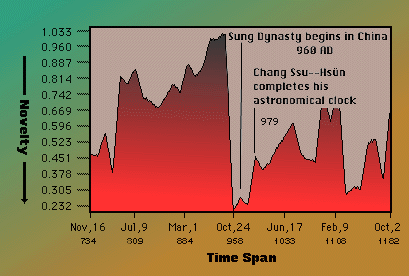

Joseph Needham had this to say concerning the invention of Chang Ssu-Hsün:
With Chang Ssu-Hsün's apparatus we come to an indubitable astronomical clock, composed mainly of an armillary sphere (demonstrational), or a celestial globe, activated by a scoop-bearing driving wheel and gearing something like Su Sung's, and not lacking mechanical figures to sound the hours....It is evident that Chang's clock was a very fine construction, particularly interesting in that mercury was employed in the closed circuit instead of water, thus enableing time to be kept even in hard freezing weather. But it must have been rather beyond the general level of the time, for after Chang's death it very soon went out of order and there was no one to keep it going.From the point of view of Novelty Theory it is clear that what Chang built was a mechanical model of the cosmos, a sort of technologically based totality symbol in the Jungian sense. This Universal modeling device, running on alchemical mercury that would later be found to carry superconductivity represents not only an enormous conceptual and technical breakthrough for its time, it also represents an unusually clear anticipation of the Eschaton in its guise as perfect model and perfected dimension roving machine/vehicle.